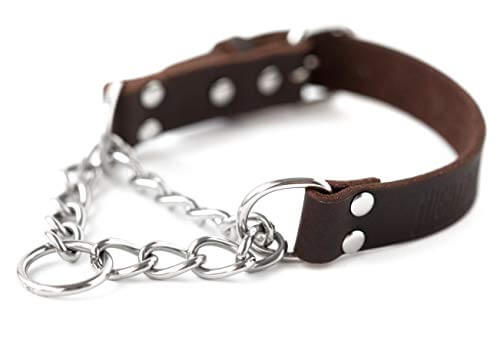Right Way to Attaching the Leash to Your Dog's Choke Chain Style Collar

Are you planning to use a choke chain style collar for training your dog? If so, then you must be aware of the significance of attaching the leash to the choke chain style collar correctly. The correct use of a choke chain style collar ensures the safety of your dog, in case he attempts to run away. Usually, these collars are used for controlling and correcting your dog's behavior.
It is significant to attach the leash to the choke chain style collars properly to get the most out of them. The most commonly used styles of choke chain collars include prong collars, martingale collars, and slip collars.
In this article, we will elaborate on where you should pair the leash to your dog's choke chain style collar. So, let's have a look at the different styles.
What Is The Right Way To Attach A Leash To A Choke Chain Style Collar?
There are various styles of choke chain collars that you can choose from for your dog. The most common styles are prong collars, martingale collars, and slip collars. There is a different way to attach the leash to each type of collar. Read on to know more about them.
Prong Collars
Prong collars sit high on the dog's neck, right behind their ears. They are made of prongs and exert pressure equally across the dog's neck. It should tightly fit to avoid rubbing against the dog's neck, putting uneven pressure.
Many people get confused about how to attach the leash to a prong collar. Most prong collars have two rings to which the leash is attached. You must join the leash to the outer ring of the prong collar. In case you attach the leash to the inside ring, it makes you lose mobility for the sliding action.
Consequently, it will create a consistent pulling motion, which is a cruel way to use a prong collar. It will not serve the purpose of training your dog effectively. Also, some people make the mistake of joining the leash to both rings. Doing so will not serve the purpose as it may lead to exerting more pressure.
Martingale Collars
Martingale collars look like regular collars and do not sit high on the neck. However, there is a loop that tightens with pressure. The leash is attached to the D ring adjoining the loop.
Typically, these collars consist of one outer ring and two inside rings. You must attach the leash to the outer ring. If you experience an instant tightening of the collar while pulling on the leash, it means that the leash is attached to the correct ring.
Also, loosen up the collar a bit once you are sure that the leash is attached to the ring correctly. It is better to have a little loose training color. The martingale attachment must go above a dog's neck to apply pressure properly.
Slip Collars
Slip collars are simple, having a loop on one end, while on the other end, a rope ring is made into a loop to place over the dog's head. It is a safe option to use for people having a delicate dog or a new puppy. They are gentle and light on your dog's neck. Therefore, a slip collar is a suitable option for puppies with less fat on their neck.
The leash is attached to the outer ring, similar to a prong collar. The only difference between prong and slip collars is the prongs element.
A slip collar allows for a smooth and quick leashing of your canine. It feels light and loose while walking your dog. You may gradually tighten it when implementing corrections.
Mostly, a slip collar is sufficient to leash train the dogs. However, a prong collar is a better option for canines manifesting extreme pulling behavior. It is ideal for strong dogs as it teaches them a little self-restraint.
Bottom Line:
To sum up, a choke chain style collar is an effective training tool allowing you to walk your dogs safely. The various collar styles come with different rings and loops to which you can attach the leash. Be sure to attach the leash to the outermost ring of a choke chain style collar. Also, ensure whichever collar you choose suits your dog's needs and behavior. Hopefully, by now, you have a clear idea about different choke chain collar styles and how you can attach a leash to them.
839GYLCCC1992



Leave a Reply